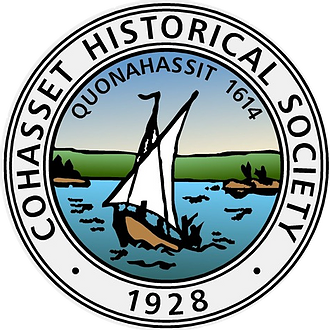Seaside Fashions
Seaside Fashions During The Gilded Age
Fashion did not take a holiday during summers in the Gilded Age. Indeed, seaside resorts were as likely a place to show off one’s style as cities like Boston and New York, with their established social clubs and exclusive associations.
Splendid as they have been in the season just ended, dresses to be worn at the Seaside, and at the mansions of our Aristocracy, often surpass those that have been worn in London or Paris, during the height of the Season. (Ladies’ Monthly Magazine, 1869)
Haas Brothers, middy dress, 1895, cotton pique, The Museum at FIT (P84.25.2).
For the elite of Boston, escaping from the damp heat of the summer required a large staff just to get ready for the trip to Cohasset or other seaside communities.
If you were going to the shore your coachman would load a huge pile of horse-hide trunks filled with feminine furbelows and cart them down to the Boston and Hingham Steam Boat at Rowe’s Wharf. (Yankees under Steam, ed. Austin N. Stevens, Yankee Magazine, p. 175.)
Steamers, like the Rose Standish, built in 1863, or the Mayflower, built in 1891, which stopped at Nantasket and Pemberton in Hull, were kept in top condition. Some steamboats, which traveled greater distances, could accommodate up to 800 or more passengers. Others, like the Sound Steamers, a special class that traveled from New England to New York, became floating palaces with gilt, marble, velvet, and rooms even larger than any hotel on land. The Fall River Line, with passengers going to Newport, counted amongst its regulars the Vanderbilts, Astors, Belmonts and Rockefellers, and on occasion, Presidents Grant, Harrison, Cleveland and the two Roosevelts. The grand saloon of the Commonwealth was done in Venetian Gothic, her dining room in Louis XVI and her café in 16th-century Italian.
Once there at their seaside “cottages,” summer residents needed all manner of domestic help to entertain, but also to dress for the variety of day and evening activities they gave or attended. Along with cooks and butlers at home, ladies’ maids and valets were required for the many rowing parties and picnics, horse shows and summer balls, who could choose, lay out, wash, press, and even help with tightly fitted corsets and the metal hooks of riding boots.
Day trippers (who could only afford a Sunday visit to the beach), conscious of their social status, often came in fancy afternoon attire, like the frolicking women and children bathing among the breaking waves and slippery rocks – in Maurice Prendergast’s two watercolors, Surf Nantasket and Surf Cohasset, dated ca. 1900-1905. Unlike the quiet Luminism of artists who came to Cohasset after the Civil War to paint the poetic beauty of its shoreline, Prendergast’s art from 1900 is filled with a nervous energy and luminosity. In his watercolors, he applied colors wet so that they blur and sparkle like so many jewels or the reflections of sunlight. Blues and greens - with touches of yellow, brown and violet - replace the bright primary colors that he had favored in the 1880s and 1890s.
Maurice Prendergast, Surf Cohasset, ca. 1900-05, watercolor, private collection.
Maurice Prendergast, Surf Nantasket, ca. 1900-05, watercolor, private collection.
Prendergast (1858-1924) was born in Newfoundland but grew up in Boston’s South End and was first apprenticed to a commercial sign painter. Between 1891 and 1900, he studied in Paris and Venice with his brother Charles and absorbed the lessons of the Post-Impressionists. From Paul Cezanne and Pierre Matisse, he learned to flatten his subjects, creating frieze-like, mosaic patterns.
Popular and successful, Prendergast was known for his elegant but playful “modern” American scenes. He enjoyed sketching wherever people gathered in parks or by the shore for festivals and leisure activities. Back in his studio, he added watercolors with the aid of notes recalling the hues he had admired in nature.
This essay was researched and written by Paula Morse, Cohasset Historical Society board member and museum planner




